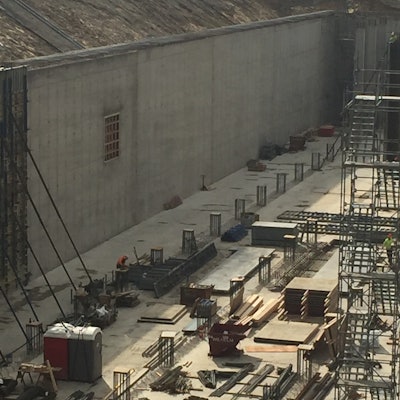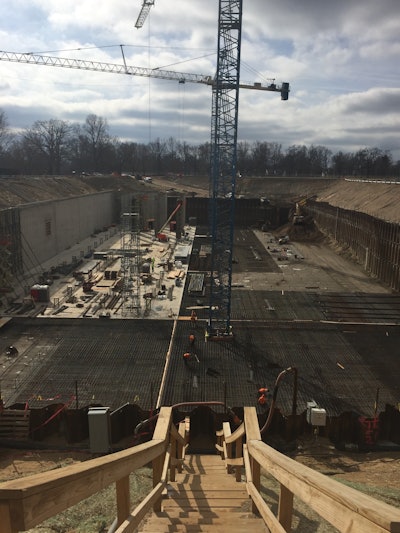
Project: Shawnee Park Basin; Louisville, Ky.
Concrete Contractor: Wilhelm Construction; Indianapolis, Ind.
Concrete Supplier: Allied Ready Mix Company LLC; Louisville, Ky.
GCP Solutions: CONCERA admixtures
The Shawnee Park Basin Project will create a cleaner river, provide new park amenities and preserve the historic nature of Shawnee Park in Louisville, Ky.—but the benefits don’t come without their trials. At 20 million gallons deep, the size of the underground basin created complex concrete challenges.
The Project
The recently completed $60 million Shawnee Park Basin Project is part of a federal mandate to prevent waste water from pouring into the Ohio River. It is a watertight concrete structure designed to capture 20 million gallons of untreated wastewater during storm events, instead of it flowing into the Ohio River. The top of the basin is approximately 12 feet below grade with reinforced concrete that is more than 36 inches thick. Wastewater is stored in the basin until a storm subsides, then pumped to the nearest treatment center, treated and returned to local streams or to the Ohio River. Forming for the roof slab in progress
Forming for the roof slab in progress
The Challenge
Wilhelm Construction, one of Indiana’s largest concrete contractors, was tasked with overseeing the quality control of the concrete for the project, including managing the mix design, temperature control and testing. The enormity of the basin’s design required over 30,000-cubic-yards of concrete—and placing the large amounts of concrete without any honeycombing or cracking was one of the biggest challenges the team faced.
In addition, constructing an underground basin of this magnitude created other daunting issues, including:
- Completing the placement of the large amounts of concrete efficiently, each pour taking 6-8 hours
- Getting the concrete to properly flow around reinforcing steel rebars and wall ties
“The massive underground sewage basin required 30,000+ cubic yards of concrete. When placing that much concrete a lot of things can go wrong,” explains Larry Arthur, Wilhelm Construction, president of ACI Indiana Chapter.
The Solution
After careful consideration and many tests, Wilhelm Construction selected control flow concrete with CONCERA admixtures as the best solution for the massive basin concrete project. In this project, the control flow concrete had a slump flow of 22 inches, which is less than most self-consolidating concrete. The concrete produced with CONCERA admixtures flows easily, requiring only minimal energy to move. This flowability allowed trouble-free placement around the steel reinforcement.  Early project wall and slab construction begins
Early project wall and slab construction begins
In addition, more was accomplished each day since the concrete discharge and placement was significantly faster, and material costs were lower than for self-consolidating concrete.
“With CONCERA admixtures we were able to use just one chemical, and it still worked more efficiently. When we saw how the concrete moved and flowed, we knew it was the best fit for what we needed. CONCERA is the first admixture we have used that truly stands out,” adds Arthur.
This case study was submitted by GCP Applied Technologies Inc.


















